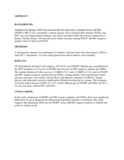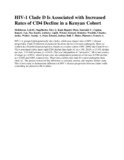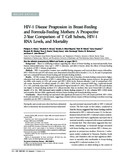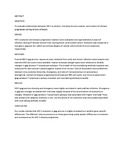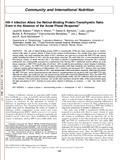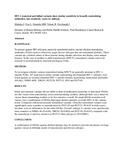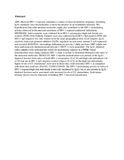Browsing Faculty of Health Sciences (FHS) by Title
Now showing items 4399-4418 of 10378
-
Hiv Type 1 Subtypes In Circulation In Northern Kenya.
(University of NairobiSchool of Public Health Centre for HIV Prevention and Research, 2005)Kenya Medical Research Institute, Nairobi, Kenya. skhamadi@nairobi.mimcom.net The genetic subtypes of HIV-1 circulating in northern Kenya have not been characterized. Here we report the partial sequencing and analysis of ... -
HIV type 1 transmission networks among men having sex with men and heterosexuals in Kenya
(University of Nairobi, 2014)We performed a molecular phylogenetic study on HIV-1 polymerase sequences of men who have sex with men (MSM) and heterosexual patient samples in Kenya to characterize any observed HIV-1 transmission networks. HIV-1 polymerase ... -
Hiv Vaccine Efficacy Trials: A Brief History, And Options For Going Forward.
(University of NairobiDepartment of Medical Microbiology, 2010-10)HIV vaccine research has recently produced a number of efficacy results, in addition to some promising preclinical developments. Some of these have been surprising, leading to parallel calls for a better understanding of ... -
HIV viral set point and host immune control in individuals with HIV-specific CD8R T-cell responses prior to HIV acquisition
(2010)OBJECTIVE: Vaccine-induced CD8(+) T-cell responses in primates have been associated with a reduced simian immunodeficiency virus plasma viral load and enhanced T-cell responses, but cellular vaccines have shown limited ... -
HIV with non-communicable diseases in primary care in Kibera, Nairobi, Kenya: characteristics and outcomes 2010–2013
(University of Nairobi, 2015)BACKGROUND: Antiretroviral therapy (ART) has increased the life expectancy of people living with HIV (PLHIV); HIV is now considered a chronic disease. Non-communicable diseases (NCDs) and HIV care were integrated into ... -
HIV, violence and women: Unmet mental health care needs
(University of Nairobi, 2014-12)Background HIV-infected (HIV+) women have high rates of Gender Based Violence (GBV). Studies of GBV find that approximately 50–90% of survivors develop mood and anxiety disorders. Given that women in sub-Saharan African ... -
HIV-1 acquisition and disease progression are associated with decreased high-risk sexual behaviour among Kenyan female sex workers.
(2006)BACKGROUND: Changes in sexual risk behaviour may occur following HIV-1 infection. OBJECTIVE: To test the hypothesis that HIV-1 seroconversion and disease progression are associated with changes in risk behaviours, ... -
HIV-1 and immunological changes during pregnancy: a comparison between HIV-1-seropositive and HIV-1-seronegative women in Nairobi, Kenya.
(University of NairobiDepartment of Obstetrics and Gynaecology, 1995-09-09)OBJECTIVE: To assess changes in the proportion of CD4 and CD8 T-lymphocyte profiles during pregnancy, at delivery and postpartum, and to determine whether HIV-1 infection affects the normal profile. DESIGN AND METHODS: A ... -
HIV-1 and reproductive health in Africa
(University of NairobiDepartment of Medical Microbiology, 1994-02)In many African countries where HIV infection is mainly heterosexually transmitted a substantial proportion of women of childbearing age are now infected with the virus. This paper will review the consequences of HIV-1 ... -
HIV-1 Clade D Is Associated with Increased Rates of CD4 Decline in a Kenyan Cohort
(University of Nairobi, 2012)HIV-1 is grouped phylogenetically into clades, which may impact rates of HIV-1 disease progression. Clade D infection in particular has been shown to be more pathogenic. Here we confirm in a Nairobi-based prospective female ... -
HIV-1 Clade D Is Associated with Increased Rates of CD4 Decline in a Kenyan Cohort
(2012)HIV-1 is grouped phylogenetically into clades, which may impact rates of HIV-1 disease progression. Clade D infection in particular has been shown to be more pathogenic. Here we confirm in a Nairobi-based prospective ... -
HIV-1 disease progression in breast-feeding and formula-feeding mothers:
(Department of Pediatrics, University of Nairobi, Nairobi, Kenya, 2007)Background. There is conflicting evidence regarding the effects of breast‐feeding on maternal mortality from human immunodeficiency virus type 1 (HIV‐1) infection, and little is known about the effects of breast‐feeding ... -
HIV-1 Drug Resistance Mutations Among Infants Born to HIV-Positive Mothers in Busia, Kenya
(University of Nairobi, 2014)To determine HIV-1 subtypes and transmitted HIV-1 drug-resistant mutations among HIV-1-positive children born to HIV-positive mothers in Busia County, blood samples were collected from 53 children aged between 6 weeks and ... -
HIV-1 Env-specific cytotoxic T-lymphocyte responses in exposed, uninfected Kenyan sex workers: a prospective analysis.
(University of NairobiDepartment of Medical Microbiology, 2004-10-21)The prospective significance of HIV-specific cytotoxic T lymphocyte (CTL) responses in highly exposed, persistently seronegative populations is unknown. In 1996-1997 we screened for CTL responses against HIV clade B Env ... -
HIV-1 evolution in gag and env is highly correlated but exhibits different relationships with viral load and the immune response
(Division of Human Biology, Fred Hutchinson Cancer Research Center, Seattle, Washington 98109-1024, USADepartment of Medical Microbiology, University of Nairobi, 2009)OBJECTIVE: To evaluate relationships between HIV-1 evolution, including immune evasion, and markers of disease progression during chronic infection. DESIGN: HIV-1 evolution and disease progression markers were evaluated ... -
HIV-1 infection alters the retinol-binding protein:transthyretin ratio even in the absence of the acute phase response.
(University of Nairobi,College of Health Sciences,, 2005)he ratio of retinol-binding protein (RBP) to transthyretin (TTR) has been proposed as an indirect method with which to assess vitamin A status in the context of inflammation. Few studies have been conducted among adults, ... -
HIV-1 maternal and infant variants show similar sensitivity to broadly neutralizing antibodies, but sensitivity varies by subtype
(University of NairobiSchool of Public Health, 2013-06-19)RATIONALE: To protect against HIV infection, passively transferred and/or vaccine-elicited neutralizing antibodies (NAbs) need to effectively target diverse subtypes that are transmitted globally. These variants are a ... -
HIV-1 neutralizing activity is correlated with increased levels of chemokines in saliva of HIV-1-exposed uninfected individuals.
(University of Nairobi,College of Health Sciences,, 2008)AIM: Mucosal HIV-1 exposure stimulates a variety of mucosal immune responses, including IgA1-mediated virus neutralization, even in the absence of an established infection. We hypothesized that other immune molecules might ... -
Hiv-1 neutralizing antibodies with limited hypermutation from an infant.
(University of Nairobi, 2016)HIV-1 broadly neutralizing antibodies (bnAbs) develop in a subset of infected adults and exhibit high levels of somatic hypermutation (SHM) due to years of affinity maturation. There is no precedent for eliciting highly ... -
HIV-1 neutralizing antibody breadth is affected by factors early in infection, but does not influence disease progression. Journal of Virology 83(10):10269-74
(University of Nairobi, 2009)No abstract available




